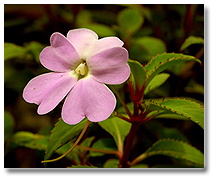How to Grow Impatiens
![]()

By: Emily Mootz
Impatiens are a very beautiful plant.
They are also relatively easy to grow.
Here is some information that will make caring for them a little easier.
Soil
Before planting impatiens either inside or outside you should make sure you have soil that is appropriate. Impatiens prefer rich, loose, well drained soil. For indoor planting, it is suggested that you purchase a potting mix soil such as, Sunshine Mix. As for outdoors, adding organic matter every year is highly suggested to keep plenty of organic material in the soil. It is also advised that you keep your impatiens well mulched.
Propagation
Impatiens can be started either inside, or they can be planted outside in the spring once the chance of frost has passed. However, if you are looking for the quickest results it is best to start them indoors with a heated germination mat.
Once you can see the plant begin to emerge from the soil, allow several weeks more time for growth before transplanting outside. This time allows the plant to get a good start, and will make it a little less vulnerable to pests and cool weather outside.
Watering
Impatiens absorb soil moisture quickly. They should be watered on a regular basis. If you have good soil (high in organic matter) you should only need to water once weekly, twice weekly during dry spells. However, if you have poor soil (low in organic matter) you will want to water daily.
To get the best performance out of your impatiens you should not allow extremes in water, which is not let your flowers get too dry then too wet. This is very stressful on flowers. To avoid this problem you can install a watering system. The most widely used for flowers planted outside in flower beds or garden is a drip irrigation system hooked up to a timer. This allows you to be worry free if you have to be absent from your flowers. The timer allows you to easily adjust the amount of water your flowers get. And can be changed according to the weather. The drip system allows a uniform watering to all plants along the hose. This hose is also easy to install. You can simple lay it on the top of your soil and cover with mulch.
Fertilizing
With impatiens fertilizing is strictly an option.
If you do decide to fertilize it is best to use a fertilizer that is a general purpose, slow-acting, granules. This can be sprinkled onto the surface of the soil at planting time in very minimal amounts.
Some people like to give their flowers an extra boost in mid-summer. This is a good idea if you have poor soil, but again, is strictly optional.
One caution with fertilizing impatiens, and many other plants, is that too much fertilizer can cause your flowers to get very “leggy” and produce a lot of foliage with very little blossoms.
Where to Plant
Impatiens can be planted in outdoor pots, gardens, flower beds or kept inside as long as they have part to full shade. Most impatiens can get up to 24” tall. It is recommended to space the plants about 12”-18” apart. This will allow room for the plant to expand and grow to its full size without looking too big.
Insect and Disease
Impatiens have some occasional problems with aphids and mites. To help cure this problem you can use an insecticidal soap or a repellent. If this problem continues about a week and a half after applying product, then you can treat with fungicide.
Pruning/Grooming
If it inevitable, things tent to deteriorate with age. This is also true with impatiens. Weekly grooming is recommended to keep your plants looking attractive. In this weekly grooming you should remove dead leaves and stems. It is also a good idea to pinch off the spent blossoms. This step will help to greatly reduce chance of getting a disease.
Close to the end of the hot summer days your impatiens will start to look a little “leggy,” even if you did not use fertilizer. To renew your flowers you should pinch the tips of the stems back about three or four inches with your fingers or pruners. This will temporally stop blooming of your flowers, but soon you will enjoy many new branches and a more compact shape with many new flowers.
Impatiens are very sensitive to cold. So, it is a good idea to bring in your impatiens inside before the nighttime low gets below 34ºF.
Gardnersnet
Gardenhobbies
Yardener